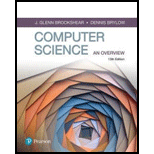
Concept explainers
Soda dispensing machine:
Soda dispensing machine is an electronic device which dispenses soda or carbonated drinks for certain sum of money in exchange.
Agent:
Agent in context to soda dispensing machine is a device which senses the response of an individual and performs the task accordingly.
Sensors:
Sensors are the electronic devices and a part of a machine which detects or sense certain activities for which these are designed and record it.
Actuators:
Actuators are the electronic device and a part of a machine which controls the several functions and
Level of response by a machine:
A machine includes several devices; each contains specific purpose and gives different types of response such as:
- Reflex: It is a level of response by any machine in which an action is performed to certain behavior.
- Knowledge based: It is a level of response by any machine which requires an intellectual behavior and characteristics.
- Goal based: It is a level of response by a machine which establishes a goal or objectives to be performed.
Want to see the full answer?
Check out a sample textbook solution
Chapter 11 Solutions
Computer Science: An Overview (13th Edition) (What's New in Computer Science)
- What are three examples of discrete event simulation?arrow_forwardConsider the diagram of Figure 2.16. A robot is set up 1 meter from a table. The tabletop is 1 meter high and 1 meter square. A frame o1x1y1z1 is fixed to the edge of the table as shown. A cube measuring 20 cm on a side is placed in the center of the table with frame o2x2y2z2 established at the center of the cube as shown. A camera is situated directly above the center of the block 2m above the tabletop with frame o3x3y3z3 attached as shown. Find the homogeneous transformations relating each of these frames to the base frame o0x0y0z0. Find the homogeneous transformation relating the frame o2x2y2z2 to the camera frame o3x3y3z3. *** Note – Draw the frame rotations wherever necessary from the starting to destination frame. Show the necessary stepsarrow_forwardHow come it's crucial to represent single-occurrence phenomena?arrow_forward
- What is the significance of discrete event simulation?arrow_forwardWhat is the purpose of discrete event simulation?arrow_forwardAccording to Schinzinger (1996), engineering as a social experimentation is not an experiment conducted solely in a laboratory under controlled conditions. Rather, it is an experiment on a social scale involving human subjects. Discuss your view on this statement.arrow_forward
 Database System ConceptsComputer ScienceISBN:9780078022159Author:Abraham Silberschatz Professor, Henry F. Korth, S. SudarshanPublisher:McGraw-Hill Education
Database System ConceptsComputer ScienceISBN:9780078022159Author:Abraham Silberschatz Professor, Henry F. Korth, S. SudarshanPublisher:McGraw-Hill Education Starting Out with Python (4th Edition)Computer ScienceISBN:9780134444321Author:Tony GaddisPublisher:PEARSON
Starting Out with Python (4th Edition)Computer ScienceISBN:9780134444321Author:Tony GaddisPublisher:PEARSON Digital Fundamentals (11th Edition)Computer ScienceISBN:9780132737968Author:Thomas L. FloydPublisher:PEARSON
Digital Fundamentals (11th Edition)Computer ScienceISBN:9780132737968Author:Thomas L. FloydPublisher:PEARSON C How to Program (8th Edition)Computer ScienceISBN:9780133976892Author:Paul J. Deitel, Harvey DeitelPublisher:PEARSON
C How to Program (8th Edition)Computer ScienceISBN:9780133976892Author:Paul J. Deitel, Harvey DeitelPublisher:PEARSON Database Systems: Design, Implementation, & Manag...Computer ScienceISBN:9781337627900Author:Carlos Coronel, Steven MorrisPublisher:Cengage Learning
Database Systems: Design, Implementation, & Manag...Computer ScienceISBN:9781337627900Author:Carlos Coronel, Steven MorrisPublisher:Cengage Learning Programmable Logic ControllersComputer ScienceISBN:9780073373843Author:Frank D. PetruzellaPublisher:McGraw-Hill Education
Programmable Logic ControllersComputer ScienceISBN:9780073373843Author:Frank D. PetruzellaPublisher:McGraw-Hill Education





